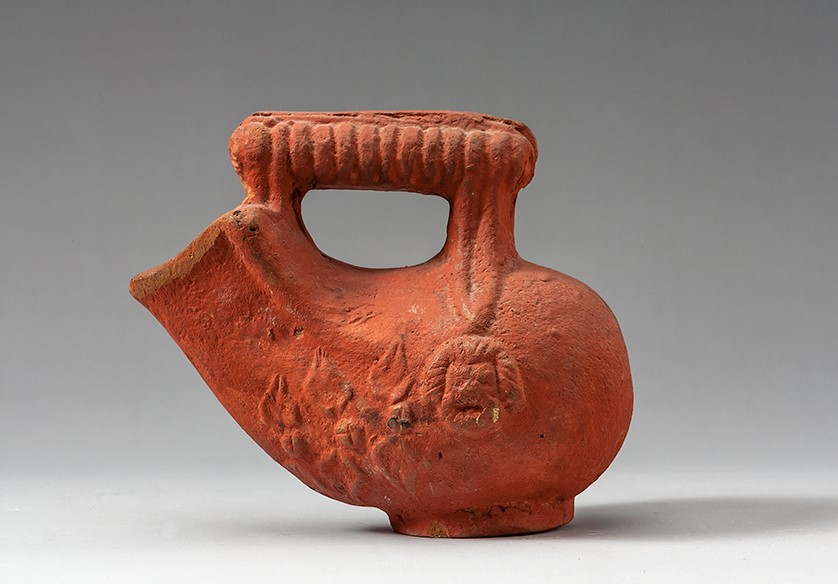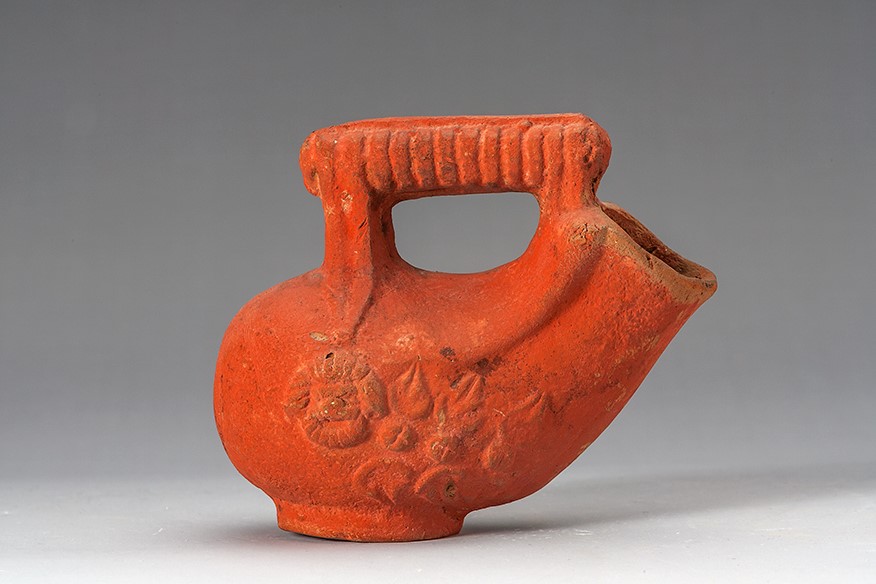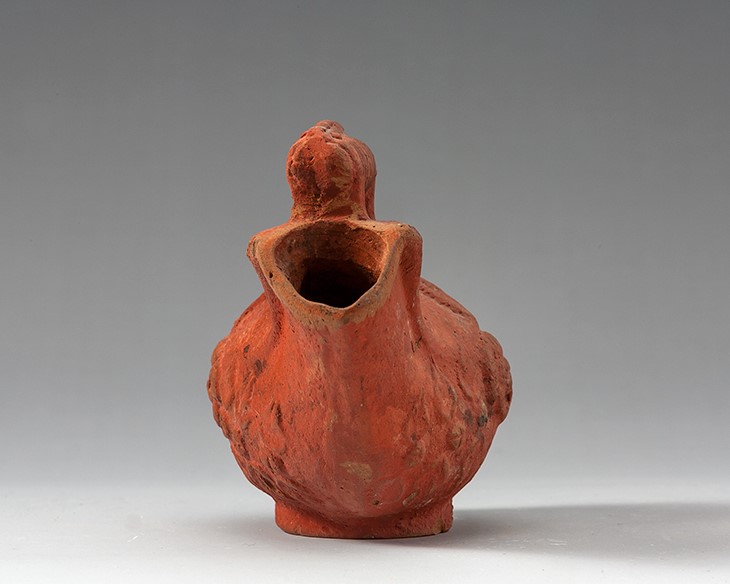Acquisition number: 1984.03
Intact and in good condition but for some wear about the spout. Rather rough pale brown clay with small white inclusions and occasional voids. The shape is that of a formalised wine-skin. The vase was made in a pair of matching moulds and a disc foot added. The finish is fairly rough.
The handle is a horizontal bar of circular section with flat ridges along the sides. A double fillet runs down each side from the rear handle junction. At the forward part of the vessel, a ridge runs from the upper edge of the mouth along the shoulder. On the sides is a frontal comic mask flanked towards the spout by fruited ivy.
The paint is a matt pinkish-red; it was applied over all external surfaces but there are only dribbles of paint on the underside. There is no wash inside.
Title: Romano-Egyptian Askos - 1984.03
Acquisition number: 1984.03
Author or editor: J.R. Green
Culture or period: Roman Imperial
Date: 2nd century AD.
Material: Clay - Terracotta
Object type: Vessels - Askos
Dimensions: 116mm (w) × 98mm (h)
Origin region or location: Egypt
Origin city: Alexandria
Display case or on loan: 11
Keywords: Roman, Imperial, Romano Egyptian, Dionysos, Roman Egypt, Moustaki Collection, Alexandria
Charles Ede Ltd (London), Antiquities130 (March 1980) no. 20 (ill.); MNC3 5EV 2.
1984.03
Romano-Egyptian Askos
Purchased. Ex colls. Moustaki and then Mrs E. McLellan (and therefore probably from the neighbourhood of Alexandria). Max. ht 9.8cm; length 11.6cm.
Intact and in good condition but for some wear about the spout. Rather rough pale brown clay with small white inclusions and occasional voids. The shape is that of a formalised wine-skin. The vase was made in a pair of matching moulds and a disc foot added. The finish is fairly rough.
The handle is a horizontal bar of circular section with flat ridges along the sides. A double fillet runs down each side from the rear handle junction. At the forward part of the vessel, a ridge runs from the upper edge of the mouth along the shoulder. On the sides is a frontal comic mask flanked towards the spout by fruited ivy.
The paint is a matt pinkish-red; it was applied over all external surfaces but there are only dribbles of paint on the underside. There is no wash inside.
Perhaps of the second century AD. It is highly probable that the moulds were taken from a metal vessel and then used for reproductions in clay.
The mask is that of a slave from Comedy; it has a wide striated trumpet-beard, and striated hair with full side-hair. As was can tell from its popularity in reproductions, the mask was taken as the most characteristic of the comic theatre and, by extension, of the happy world of Dionysos who was also god of wine. Ivy was also symbolic of his world.
The shape is not uncommon; for comparable examples, see e.g. Corpus Vasorum Antiquorum Brussels (3) pl. 2 (140), 8, 10 and 14. As one might guess from its appearance, the shape seems to be most at home in bronze: see J.W. Hayes, Greek, Roman and Related Metalware in the Royal Ontario Museum (Toronto 1983) 70-72 (with refs); F. Proto, “Gli askoi: categoria Z”, in: S. Passinari (ed.),Vasi in bronzo: brocchi, askoi, vasi a paniere (Naples 2009) 141-168. They are not infrequent at Pompeii: see for example M.R. Boriello et al., Le collezioni del Museo Nazionale di Napoli. I Mosaici etc. (Rome 1986) 178-9 nos 43 and 44; L.P. Biroli Stefanelli (ed.), Il bronzo dei Romani: arredo e suppellettile (Rome 1990) 240-241, figs 226-227 although they tend to be larger than ours. At Pompeii there is also an amusing image of an attendant carrying two such askoi in a mosaic in the entrance passage to the caldarium of the House of the Menander, e.g. R. and L. Ling, The Insula of the Menander at Pompeii, ii (Oxford 2005), colour pl. 41.
There are notes on the shape (but not the ware) by P. Roberts in N. Crummy (ed.), Image, Craft and the Classical World. Essays in Honour of Donald Bailey and Catherine Johns (Monographies Instrumentum, 29, Montagnac 2005) 23-38.
Charles Ede Ltd (London), Antiquities130 (March 1980) no. 20 (ill.); MNC3 5EV 2.


